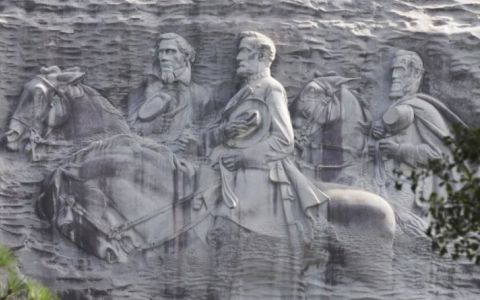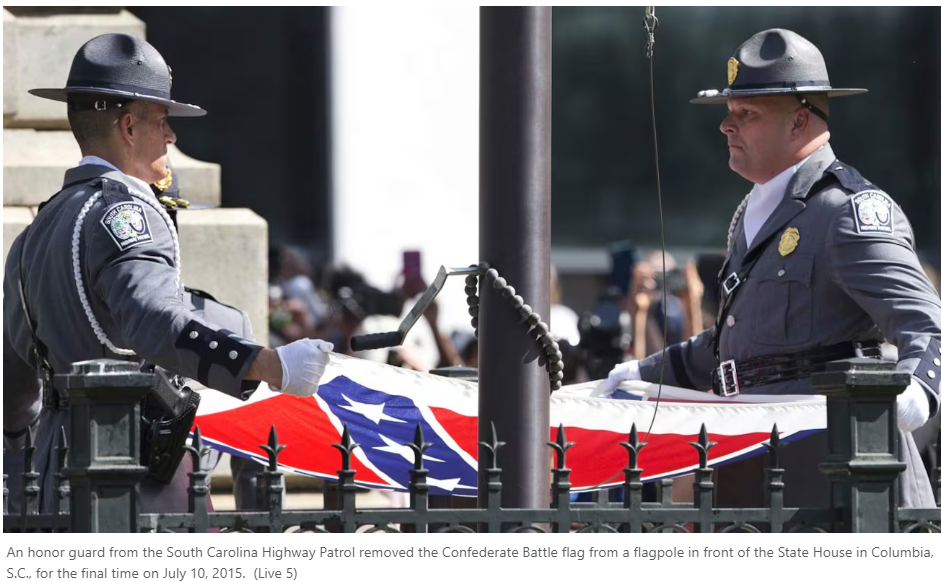STONE MOUNTAIN, Ga. — Of all the Confederate monuments under fire, few are more figuratively weighted — and literally fixed — than the 1,700-foot high outcropping of granite outside Atlanta with carvings of Robert E. Lee, Thomas “Stonewall” Jackson and Jefferson Davis.
Covering more than 17,000 square feet of mountain and 40 feet deep in the crannies, the carving is reportedly the largest flat relief sculpture in the world. Looming over a popular public park like a stone-age billboard, it was conceived by Southern Confederate groups a century ago at the birthplace of the modern Ku Klux Klan and remains an icon for white supremacists.
Now, calls to remove what may be the planet’s largest Confederate monument have roiled Georgia’s gubernatorial election and sparked what could be the most complex of the hot-button Rebel memorial fights erupting across the country.
Stacey Abrams, the African American minority leader of the Georgia House of Representatives who is seeking the Democratic nomination for governor, last month declared the carving “a blight on our state” and called for its removal. Several Atlanta Democrats and te local NAACP joined her. Many Republicans and Southern heritage groups condemned her position as divisive.
“Instead of dividing Georgians with inflammatory rhetoric for political gain, we should work together to add to our history, not take from it,” Republican Lt. Gov. Casey Cagle (R), who is also running for governor, said in response to Abrams’s call.
Not every black leader has embraced the move to scrub the three horsemen from Stone Mountain. Former Atlanta mayor and civil rights standout Andrew Young said sandblasting the mountain could amount to a damaging “re-fight” of the Civil War. And political observers are not sure how hot the issue will burn in a state that is growing younger and, slowly, more Democratic in recent years.
“For old-line Georgians, I think this will be a big thing,” said University of Georgia political science professor Charles Bullock. “For younger ones, not so big.”
Whatever the politics, Stone Mountain — where carvers working on the sculpture were known to shelter from storms in the mouth of Lee’s horse — will be different than in cities such as Baltimore and New Orleans, where statues have been recently been spirited from their pedestals at night.

The carved figures, from left, of Rebel leaders Jefferson Davis, Robert E. Lee and Thomas “Stonewall” Jackson at Stone Mountain, Ga. (AP Photo/John Bazemore)
“This one can’t be moved,” said Emory University historian Joe Crespino, who has written extensively about the origin and meaning of Confederate memorials. “It’s the side of a mountain. You either destroy it or leave it in place.”
[The day white Virginia stopped admiring Gen. Robert E. Lee and started worshiping him]
While activists just want these carved-in-stone elegies to the Confederacy gone, scholars typically call for the statues to be shifted from places of honor to educational settings, with placards and curators telling stories of when and why they were erected. At Stone Mountain, Crespino said he would like to see officials add signage detailing the full history of the art while also scrubbing the park of some of the more changeable tributes, such as the names of Robert E. Lee Boulevard and Jefferson Davis Drive.
 Naomi Jones, a frequent picnicker at Stone Mountain, said she has mostly ignored the park’s massive monument to Confederate leaders. Now she wants it removed. (Steve Hendrix/The Washington Post)
Naomi Jones, a frequent picnicker at Stone Mountain, said she has mostly ignored the park’s massive monument to Confederate leaders. Now she wants it removed. (Steve Hendrix/The Washington Post)Naomi Jones would go further.
On a recent summer Sunday, Jones was at the park to picnic with her grandsons and take a Duck Boat tour of Stone Mountain Lake, one of 4 million annual visitors to the 3,200-acre compound of walking paths and amusement rides. An African American resident of nearby Lawrenceville, Jones holds an annual pass and barely notices the carving on her regular visits.
She calls the place “peaceful.”
But the recent violence in Charlottesville, where city officials are waging a legal battle to relocate a Lee statue, made her take a second look at the wall looming before her folding chair. She pointed the figures out to her grandsons, ages 11, 8 and 2, and explained the history of the war and the emergence of a new white-supremacist movement. She told them about Heather Heyer, the 32-year old woman who died while protesting neo-Nazis in Charlottesville.
“The 11-year-old said, ‘If it offends some people why don’t they take it down?’ ” Jones said. “I have to say I agree with him. I don’t think adding some signs is going to do much.”
Before the 1,700-foot-high stone dome was a monument, it was a granite quarry that sent building blocks to structures such as the U.S. Capitol Building and the Panama Canal. In 1915, Helen Plane, a member of the United Daughters of the Confederacy, pushed for the southern face of Stone Mountain to be sculpted as a monument to white Southern heroes.
It was the same year that the long-defunct Ku Klux Klan announced its modern rebirth by burning a cross on the mountaintop. (The Thanksgiving-night ceremony borrowed the ritual from the recent blockbuster film “Birth of a Nation.”
[The Ku Klux Klan was dead. The first Hollywood blockbuster revived it.]

Stone Mountain was a Ku Klux Klan stronghold for decades. The modern Klan held its first cross-burning ceremony on the mountain in 1915. Here, the group gathers for a mass initiation ceremony in 1948. (AP Photo)
The time was right for an eye-popping project. It was the beginning of both the roadside tourism economy and the revisionist “Lost Cause” narrative movement, which sought to minimize preserving slavery and maximize Southern honor and state sovereignty as the reason for war. Plane gained quick support from both business people and Dixie apologists.
The first artist hired was none other than Gutzon Borglum, who would go on to carve four U.S. presidents into South Dakota’s Mount Rushmore. He was only able to whittle a gigantic silhouette of Lee’s head into Stone Mountain before a money dispute chased him from the project in 1925. Sculptor Henry Augustus Lukeman took over. He scraped away Borglum’s Lee and started fresh on the three-horsemen design before funds ran out in 1928.
The carving stood untouched for 40 years. A few years after the Supreme Court’s decision in Brown v. Board of Education, Marvin Griffin, Georgia’s newly elected segregationist governor, purchased the mountain for about $2 million in state funds, according to New Georgia Encyclopedia. Griffin formed the Stone Mountain Memorial Association to govern the public park with private investments.
Almost immediately, against the backdrop of the massive resistance movement toward dismantling segregation, monument boosters began fundraising. Workers were back on the scaffolding by 1964, this time using blow torches to chip away at the stone. “The Confederacy Rides Again — In Granite,” was the headline of a 1968 story in the Atlanta Journal-Constitution. Among those who attending the official dedication in 1970 were Vice President Spiro T. Agnew and some 10,000 visitors.
[Thurgood Marshall asked an ex-Klan member to help him make Supreme Court history]
The area remained synonymous for Klan gatherings and white-supremacist activity for several years. But it was the surrounding outdoor amenities and a privately managed amusement park that began to draw the major crowds. There are busy trails, a golf course and a lakeside Marriott resort. A popular laser show plays to pop music each night across the face of the mountain — and the faces of Lee, Jackson and Davis.
Demographic changes in DeKalb County mean that a majority of visitors on any given day are African Americans or immigrants.
“Most people who come don’t seem to think about it at all,” said John Bankhead, spokesman for the Stone Mountain Memorial Association.
Most visitors interviewed recently agreed: Confederate history hadn’t been on their minds as they rode the gondola or the scenic railroad. But the park has been the site of white-supremacist rallies in recent years. The memorial association denied a KKK group a permit to burn a cross at the park as recently as August, citing public safety concerns.
In 2015, park officials adopted a plan to add a working “freedom bell” above the carving as an homage to the Rev. Martin Luther King Jr. and this line from his 1963 “I Have a Dream” speech: “Let freedom ring from Stone Mountain of Georgia.” But that effort collapsed under criticism from both sides of the monument debate
“I don’t think there’s any way we can win with everybody,” Bankhead said.
And it’s not just the granite that guards the figures on Stone Mountain.
A portion of a 2001 state law — passed during the furor that stripped the Georgia flag of its Confederate Stars and Bars — explicitly protects the carving from being “altered, removed, concealed, or obscured in any fashion . . . for all time.”



